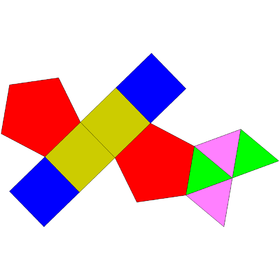Augmented pentagonal prism
| Augmented pentagonal prism | |
|---|---|
 | |
| Type | Johnson J51 – J52 – J53 |
| Faces | 4 triangles 4 squares 2 pentagons |
| Edges | 19 |
| Vertices | 11 |
| Vertex configuration | 2+4(42.5) 1(34) 4(32.4.5) |
| Symmetry group | C2v |
| Properties | convex |
| Net | |
 | |
In geometry, the augmented pentagonal prism is a polyhedron that can be constructed by attaching an equilateral square pyramid onto the square face of pentagonal prism. It is an example of Johnson solid.
Construction
[edit]The augmented pentagonal prism can be constructed from a pentagonal prism by attaching an equilateral square pyramid to one of its square faces, a process known as augmentation.[1] This square pyramid covers the square face of the prism, so the resulting polyhedron has four equilateral triangles, four squares, and two regular pentagons as its faces.[2] A convex polyhedron in which all faces are regular is Johnson solid, and the augmented pentagonal prism is among them, enumerated as 52nd Johnson solid .[3]
Properties
[edit]An augmented pentagonal prism with edge length has a surface area, calculated by adding the area of four equilateral triangles, four squares, and two regular pentagons:[2] Its volume can be obtained by slicing it into a regular pentagonal prism and an equilateral square pyramid, and adding their volume subsequently:[2]
The dihedral angle of an augmented pentagonal prism can be calculated by adding the dihedral angle of an equilateral square pyramid and the regular pentagonal prism:[4]
- the dihedral angle of an augmented pentagonal prism between two adjacent triangular faces is that of an equilateral square pyramid between two adjacent triangular faces, ,
- the dihedral angle of an augmented pentagonal prism between two adjacent square faces is the internal angle of a regular pentagon .
- the dihedral angle of an augmented pentagonal prism between square-to-pentagon is that of a regular pentagonal prism between its base and its lateral faces .
- the dihedral angle of an augmented pentagonal prism between pentagon-to-triangle is , for which adding the dihedral angle of an equilateral square pyramid between its base and its lateral face , and the dihedral angle of a regular pentagonal prism between its base and its lateral face.
- the dihedral angle of an augmented pentagonal prism between square-to-triangle is , for which adding the dihedral angle of an equilateral square pyramid between its base and its lateral face, and the dihedral angle of a regular pentagonal prism between two adjacent squares.
References
[edit]- ^ Rajwade, A. R. (2001). Convex Polyhedra with Regularity Conditions and Hilbert's Third Problem. Texts and Readings in Mathematics. Hindustan Book Agency. p. 84–89. doi:10.1007/978-93-86279-06-4. ISBN 978-93-86279-06-4.
- ^ a b c Berman, Martin (1971). "Regular-faced convex polyhedra". Journal of the Franklin Institute. 291 (5): 329–352. doi:10.1016/0016-0032(71)90071-8. MR 0290245.
- ^ Francis, Darryl (August 2013). "Johnson solids & their acronyms". Word Ways. 46 (3): 177.
- ^ Johnson, Norman W. (1966). "Convex polyhedra with regular faces". Canadian Journal of Mathematics. 18: 169–200. doi:10.4153/cjm-1966-021-8. MR 0185507. S2CID 122006114. Zbl 0132.14603.










